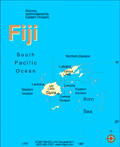Fiji
Facts & Figures

-
President: Ratu Wiliame Katonivere (2021)
Prime Minister: Voreqe "Frank" Bainimarama (2014)
Total area: 7,054 sq mi (18,274 sq km)
Population (2022 est.): 943,737 (growth rate: .44%); birth rate: 16.56/1000; infant mortality rate: 10.06/1000; life expectancy: 74.27
Capital and largest city (2018 est.): Suva (on Viti Levu), 178,000
Monetary unit: Fiji dollar
Languages: English (official), Fijian (official), Hindustani
Ethnicity/race: iTaukei 56.8% (predominantly Melanesian with a Polynesian admixture), Indian 37.5%, Rotuman 1.2%, other 4.5% (European, part European, other Pacific Islanders, Chinese)
note: a 2010 law replaces 'Fijian' with 'iTuakei' when referring to the original and native settlers of Fiji (2007 est.)Religions: Protestant 45% (Methodist 34.6%, Assembly of God 5.7%, Seventh Day Adventist 3.9%, and Anglican 0.8%), Hindu 27.9%, other Christian 10.4%, Roman Catholic 9.1%, Muslim 6.3%, Sikh 0.3%, other 0.3%, none 0.8% (2007 est.)
National Holiday: Independence Day, 2nd Monday of October
Literacy rate: 99.1% (2018 est.)
Economic summary: GDP/PPP (2020 est.): $9.86 billion; per capita $11,000. Real growth rate: 3%. Inflation: 3.4%. Unemployment: 4.5%. Arable land: 9%. Agriculture: sugarcane, coconuts, cassava (tapioca), rice, sweet potatoes, bananas; cattle, pigs, horses, goats; fish. Labor force: 353,100; agriculture 44.2%, industry 14.3%, services 41.6%. Industries: tourism, sugar, clothing, copra, gold, silver, lumber, small cottage industries. Natural resources: timber, fish, gold, copper, offshore oil potential, hydropower. Exports: $1.23 billion (2020): sugar, garments, gold, timber, fish, molasses, coconut oil. Major trading partners (exports): United States 29%, Australia 14%, New Zealand 7%, Japan 6%, Tonga 6% (2019). Imports: $1.97 billion (2020): manufactured goods, machinery and transport equipment, petroleum products, food, chemicals. Major trading partners (imports): Singapore 18%, Australia 13%, China 13.8%, New Zealand 11%, France 11%, South Korea 8% (2017).
Communications: Telephones: main lines in use: 48,51 (2020); mobile cellular: 991,500. Broadcast media: Fiji TV, a publicly traded company, operates a free-to-air channel as well as Sky Fiji and Sky Pacific multi-channel pay-TV services; state-owned commercial company, Fiji Broadcasting Corporation, Ltd, operates 6 radio stations - 2 public broadcasters and 4 commercial broadcasters with multiple repeaters; 5 radio stations with repeaters operated by Communications Fiji, Ltd; transmissions of multiple international broadcasters are available (2020). Internet hosts: 21,739 (2012). Internet users: 444,978 (2019).
Transportation: Railways: total: 597 km; note: belongs to the government-owned Fiji Sugar (2008). Highways: total: 3,440 km; paved: 1,692 km; unpaved: 1,748 km (2011 est.). Waterways: 203 km; 122 km navigable by motorized craft and 200-metric-ton barges (2012). Ports and harbors: Lambasa, Lautoka, Suva. Airports: 28 (2021).
International disputes: none.

